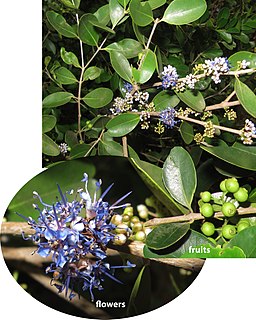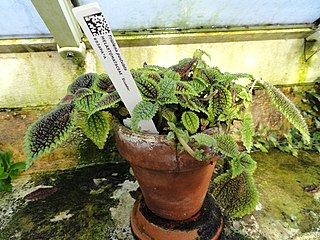
The Cucurbitaceae, also called cucurbits or the gourd family, are a plant family consisting of about 965 species in around 95 genera, of which the most important to humans are:

Tibouchina Aubl. is a neotropical flowering plant genus in Melastomataceae Juss. that contains approximately 240 species. Species of this genus are herbs, shrubs or trees and typically have purple flowers. They are native to Mexico, the Caribbean, and South America where they are found as far south as northern Argentina. Members of this genus are known as glory bushes, glory trees or princess flowers. The name Tibouchina is adapted from a Guianan indigenous name for a member of this genus [2]. A recent systematic study has shown that this genus is paraphyletic.

Monochaetum is a neotropical genus of shrubs and subshrubs with about 54 species. It occurs in warm temperate to tropical montane habitats from Mexico and Central America to the South American Andes of Colombia, Venezuela, Ecuador and Peru with one species reaching the Guayana Highlands of Venezuela and Guyana.

Melastoma affine, also known by the common names blue tongue or native lassiandra, is a shrub of the family Melastomataceae. Distributed in tropical and sub-tropical forests of India, South-east Asia and Australia, it is a plant of rainforest margins. Bees are the principal pollinators of this species.

Blakea is a genus of flowering plants in the family Melastomataceae. There are about 189 species distributed from Mexico to Bolivia and the Antilles. They are climbers, shrubs, and trees, some epiphytic.

Henriettea is a genus of flowering plants in the family Melastomataceae, with some 68 species accepted. It is distributed in the Americas. Some species in the genus are known commonly as camasey.

Memecylon is a plant group in Melastomataceae. It consists of 350-400 species of small to medium-sized trees and shrubs occurring in the Old World tropics. Memecylon is a monophyletic group basal to the Melastomataceae clade. Memecylon taxa have more than 600 published basionyms. Diversity of this group is concentrated in tropical Africa, Madagascar, Sri Lanka, India and Malaysia.

Meriania is a genus of flowering plants in the family Melastomataceae. There are about 93 species distributed from Mexico to Brazil and the Antilles.

Triolena is a genus of flowering plants in the family Melastomataceae. They are found in southern Mexico southward to Bolivia. As of 1991 there were 20 to 25 species.

Melastoma malabathricum, known also as Malabar melastome, Indian rhododendron, Singapore rhododendron, planter's rhododendron and senduduk, is a flowering plant in the family Melastomataceae. This plant is native to Indomalaya, Japan and Australia, and is usually found between 100 and 2,800 m on grasslands and sparse forests. It has been used as a medicinal plant in certain parts of the world, but has been declared a noxious weed in the United States. M. malabathricum is a known hyperaccumulator of aluminium, and as such can be used for phytoremediation.

Sonerila is a genus of plants in the family Melastomataceae. This genus is characterized by presence of three petals as opposed to five in the other members of the family. Most members of the genus prefer growing in shady habitats. It is a large genus including about 175 species.
Kailarsenia is a genus of flowering plants in the tribe Gardenieae of the family Rubiaceae. Its native range is Indo-China to West Malesia.

Larsenaikia is a genus of flowering plants in the tribe Gardenieae of the family Rubiaceae. Its native range is Eastern and Northern Australia.
Fritzschia is a genus of flowering plants in the family Melastomataceae, native to the Atlantic coastal forest of Brazil. They are sprawling or erect shrubs, with their branchlets and their hypanthia coated with either glandular or villose trichomes.
Acisanthera is a genus of flowering plants in the family Melastomataceae. It contains 11 species and is found in South America, Central America, and the Caribbean. It was described by Patrick Browne in 1756.

Bellucia is a genus of plants in the family Melastomataceae.
Arthrostemma is a genus of flowering plants belonging to the family Melastomataceae.
Conostegia is a genus of flowering plants belonging to the family Melastomataceae.
Dichaetanthera is a genus of flowering plants belonging to the family Melastomataceae.













